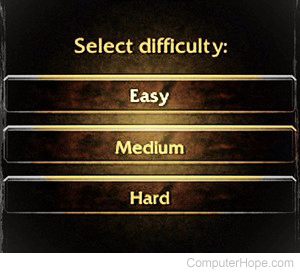Difficulty level
Updated: 06/30/2019 by Computer Hope

With video games, the difficulty level is an adjustable setting that controls how challenging a game is to play. It may affect the aggression of computer-controlled enemies, the amount of health or lives the player has, time limits of objectives, and other variables that challenge the player. The difficulty level setting generally only applies to local or single-player games where the player does not compete against other players.
Increasing the difficulty level makes a game more intense and challenging. Decreasing the difficulty level makes a game easier and less challenging. When playing a game for the first time, it is often best to try a lower difficulty level to learn how to play.
